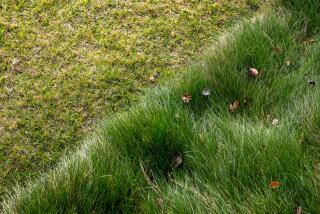GARDENING : How to Make the Grass Greener on Your Side
It’s not too late to do something about that dying lawn. Bermuda grass, our most common lawn grass (mistakenly called “devil grass” by many), goes dormant as the weather cools off and stays brown or nearly brown for most of winter and early spring.
It often doesn’t green up again until after all of the flowers you have planted this fall fade in late spring. An unfortunate but common sight in spring are gardens full of pretty flowers that are bordered by a nearly brown lawn.
There is a solution, called “over-seeding.” It is an old solution but remains a dramatic one. All you do is thin out and rough up the Bermuda grass lawn, mow it real short, and then scatter seed on top and water until it sprouts. The result is a bright, bright green lawn that lasts through winter and well into spring, when the Bermuda grass comes back to life.
The traditional grass sowed on top of the Bermuda is called annual rye. It only lives for the season, then dies and fades away in summer. It is sold in big bags at just about every nursery and building supply store at this time of the year.
How much do you need? Burkards Nurseries in Pasadena suggests 1 pound of rye grass seed for every 100 square feet of lawn, so before you head for the nursery, measure the area to be over-seeded.
Some have suggested over-seeding with perennial rye instead. The idea is that this grass will return on its own the following fall, being perennial, without reseeding. However, rye grasses, including annual rye, need to be mowed quite high, while Bermuda grass is cropped close to the ground so the rye will have a hard time surviving summer’s short mowing. Perennial rye also needs more water than Bermuda.
Annual rye, perennial rye and the new tall, turf-type fescues, should be mowed so they end up about 2 inches tall; Bermuda should be only an inch tall, or lower, after mowing.
The new turf-type tall fescues, some with brand names like Medallion, Marathon or Jaguar, are another possibility for over-seeding but here the idea is to let it take over from the Bermuda when summer comes, though I haven’t seen conclusive proof that this really works. The idea is to sow seed of a tall, turf-type fescue now, so it replaces the Bermuda by summer.
Most nurseries and gardeners still recommend annual rye, however, as a temporary winter cover and here’s how you do it:
Begin by thoroughly watering (for as long as 20 minutes) the lawn a day in advance. Then roughly rake the lawn with a steel rake or even one of the special rakes sold at nurseries that are designed to cut and rip up the Bermuda runners.
With the lawn roughed up, mow it as close to the ground as possible and then rake the lawn one more time, being sure to roughen or loosen any bare patches of soil. You are trying to make sure that the seed comes in contact with the soil.
Scatter a complete granular fertilizer (one with numbers like 10-12-10 on the label) over the lawn, following label recommendations. Now scatter the seed as evenly as possible. Don’t sow the seed too thickly or it will rot as it sprouts (from lack of air circulation).
Walk over the lawn in one direction scattering seed lightly, then go back over it again in another direction. It’s better to make several passes rather than one.
Cover the seed with a light mulch. Steer manure is the traditional favorite here because it acts as a mulch and mild fertilizer, and is cheap. If you object to the strong smell, use a product such as Kellogg’s Topper, which is also part fertilizer, part mulch. Whatever you use, you will need a 2-cubic-foot bag for every 250 square feet.
Water right away and then water often enough to keep the seed moist (hopefully we’ll get a break from these weeks of dry Santa Ana’s). Make sure the lawn is damp before going to bed at night. It takes about a week to a week and a half for the seed to sprout.






